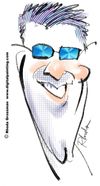Greg Aaron
 |
 |
| Country: | USA |
| Email: | gaaron [at] afilias.info |
| Facebook: | |
| LinkedIn: |
Greg Aaron is the Director of Key Account Management and Domain Security at Afilias.[1] He manages registry services for the .info TLD, and oversees Afilias' security programs, designed to address domain name abuses such as phishing, spam, malware, and fast-flux. He is also an expert on Sunrises, domain name intellectual property issues, and IDNs.
Career at Afilias edit
Greg was part of the Afilias team that launched .info in 2001 and transitioned .org to the PIR in 2003. Greg then led the development of a new, flexible registry platform for Afilias and migrated a number of ccTLDs onto it, including .ag, .gi, .hn, .la, .sc, and .vc. It is the platform still used today to support all of Afilias' TLDs.
In 2006, Greg directed the service rollout for the .mobi TLD on behalf of Afilias' customer mTLD. After a smooth rollout, .mobi has become the largest and most prominent domain from the last round of new TLDs. In 2008, Greg directed the highly successful introduction of .me, the ccTLD for Montenegro.
Greg also represents Afilias on the Steering Committee of the APWG. His recent white papers on how domain names are used for phishing have been well received.[2]
Afilias was the gold sponsor at ICANN Sydney, which Greg attended.[3]
Other Contributions edit
Greg is the chair of ICANN's Registration Abuse Policy Working Group.[4] He is a founding member of the Registry Internet Safety Group, and serves as its secretary. He is also an active member of ICANN's Fast-Flux Working Group.[5]
In 2004, Greg led the re-launch of .in, the ccTLD for India, on new systems with a set of liberalized policies; the .in domain then grew from 6,500 to more than 450,000 domains. Greg advised the Government of India and registry operator NIXI regarding domain and related Internet policies from 2004-2008,[6] and led the creation of a test-bed for deploying IDNs in Indic languages.
He is a member of the W3C's Internationalization Core Working Group and sat on the steering committee of the W3C's.[7]
Previously, he worked at Internet companies such as Travelocity and CitySearch, and in 1997 became one of the first bloggers to cover Silicon Valley.